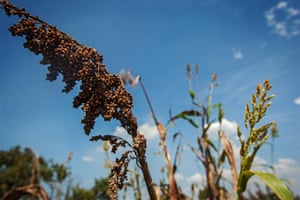Arpa-E project deploys drones and robots to breed fast-growing, drought-resistant and greener biofuel from sorghum which could replace corn ethanol

A US government agency is trying to build a better biofuel, using a higher energy-producing plant with a lower environmental impact than corn ethanol or other known biofuels.
Sorghum, a food and forage crop widely grown in Africa and Central America which has tens of thousands of varieties, has emerged as one of the most exciting prospects.
The $30m Terra project, funded by the US government’s Advanced Research Project Agency – Energy (Apra-E), seeks to use new technologies – including ground-level robots and aerial drones – to breed a fast-growing, drought-resistant biofuel that would thrive outside the rich black soils of the midwest.
The ultimate goal is to develop an alternative to corn ethanol, which demands heavy investment in water and fertiliser and takes premium farm land out of food production. A US government study in 2014 found corn ethanol was worse for global warming than gasoline under some circumstances.
In a recent interview, Ellen Williams, Arpa-E director, singled out the sorghum research as among the most exciting programmes currently funded by the agency, which was set up by Barack Obama to support early stage energy research too risky for private industry.
Researchers said they were using sensing and imaging equipment loaded on to the robots and drones to zero in quickly on varieties of sorghum that have the greatest energy potential but do not suck up too much water, fertiliser, or farm land that would otherwise be used to grow food.
Conventional plant breeding is labour-intensive and takes time, Williams said. The Arpa-E project intends to speed up that process of identifying the physical characteristics of plants and their growth potential.
“The idea is you could send a person out in the field who could look at 10 plants or you could send robots out into the field who could look at thousands of plants, and they can measure thousands of different points of data, and you can bring that data back and develop an alternative faster way of making a better selection for the breeding of your plant,” Williams said.
The scientists said they were deploying wheeled robots at ground level and 35lb flying drones, equipped with cameras, Lidar (laser scanning), hyperspectral imaging and other sensing and imaging technology to monitor the plants throughout their growing season, and so cut the time of conventional breeding.

There are more than 40,000 varieties of sorghum, most of which are used for forage crops. But very few have been extensively studied, especially for their use as a biofuel crop, the scientists said.
Advertisement
They said they were looking to develop late-flowering varieties that could thrive on relatively low-value farm land, reaching 20ft in a single season and yielding as much as 20 tonnes a hectare – or up to four times current yields.
The US Department of Agriculture has been looking for replacements for corn ethanol – especially crops that could be raised outside the premium agricultural land of the midwest – to meet quotas set by Congress for renewable transportation fuels.
Under the standards, 18bn gallons of biofuels must be blended into US petrol supply in 2016.
Scientists involved in the Terra project say that sorghum could fit the bill – because it has relatively high energy potential without demanding too much in the way of fertiliser, land or soil.
“Sorghum is a natural because it doesn’t have the competition for food,” said Barry Flinn, the Clemson University scientist overseeing the breeding project. Unlike corn, which is sensitive to heat and drought, he said: “Sorghum tends to have a natural ability to survive. It’s growing in areas where almost nothing grows.”
The plant does not require fertiliser or irrigation – and it had tremendous untapped potential as a biofuel, Flinn added.
“It has a tremendous amount of genetic diversity that hasn’t been tackled yet that we could use to really increase and substantially boost overall biomass productivity,” he said.
 Facebook Twitter Pinterest
Facebook Twitter Pinterest However, Danielle Nierenberg, founder of the Food Tank, which studies sustainable agriculture, said she was concerned about creating demand for sorghum as a fuel crop. Sorghum is an important staple in sub-Saharan Africa.
Advertisement
“My fear is that its importance as a crop high in iron, protein, and other nutrients will be overshadowed by its value for biofuels,” she said in an email. “But if farmers can use it for both fuel and food, it will do something that most other biofuel crops can’t do – provide both nourishment and fuel.”
Tim Searchinger, biofuels expert at the World Resources Institute, the environmental thinktank, rejected the entire notion that sorghum – or any biofuel – would be a better alternative to corn ethanol. “Any dedicated use of land for biofuels is a bad idea,” he said.
Existing farm lands are already under pressure to produce more food to keep up with a growing population, he said. Taking land out of food production to grow fuel would make it even harder to keep pace. In addition, he argued, plants were staggeringly inefficient at converting the sun’s rays into energy. A far better bet would be to give up sorghum and biofuels altogether, and just invest in solar panels.
“It is a waste of our money and effort,” he said. “We only have so much money we are going to throw at climate change, and even the most extraordinary example you could throw at me with sorghum, I will get more energy for less money [with] solar.”

